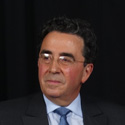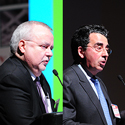Filter by
You must be a CTBUH Member to view this resource.

Turning Torso
Building
Completed
2005
Residential / Office
All-Concrete
190 m / 623 ft
57
3
147
5
5 m/s
31,840 m² / 342,723 ft²
You must be a CTBUH Member to view this resource.
You must be a CTBUH Member to view this resource.
Proposed
Construction Start
Completed
The Peer Review Engineer traditionally comments on the information produced by another party, and to render second opinions, but not to initiate what the design looks like from the start.
The Design Engineer is usually involved in the front end design, typically taking the leadership role in the Schematic Design and Design Development, and then a monitoring role through the CD and CA phases.
Other Consultant refers to other organizations which provided significant consultation services for a building project (e.g. wind consultants, environmental consultants, fire and life safety consultants, etc).
Material Supplier refers to organizations which supplied significant systems/materials for a building project (e.g. elevator suppliers, facade suppliers, etc).
You must be a CTBUH Member to view this resource.
Usually involved in the front end design, with a "typical" condition being that of a leadership role through either Schematic Design or Design Development, and then a monitoring role through the CD and CA phases.
The Design Engineer is usually involved in the front end design, typically taking the leadership role in the Schematic Design and Design Development, and then a monitoring role through the CD and CA phases.
The Peer Review Engineer traditionally comments on the information produced by another party, and to render second opinions, but not to initiate what the design looks like from the start.
The Design Engineer is usually involved in the front end design, typically taking the leadership role in the Schematic Design and Design Development, and then a monitoring role through the CD and CA phases.
The main contractor is the supervisory contractor of all construction work on a project, management of sub-contractors and vendors, etc. May be referred to as "Construction Manager," however, for consistency CTBUH uses the term "Main Contractor" exclusively.
Other Consultant refers to other organizations which provided significant consultation services for a building project (e.g. wind consultants, environmental consultants, fire and life safety consultants, etc).
These are firms that consult on the design of a building's façade. May often be referred to as "Cladding," "Envelope," "Exterior Wall," or "Curtain Wall" Consultant, however, for consistency CTBUH uses the term "Façade Consultant" exclusively.
Material Supplier refers to organizations which supplied significant systems/materials for a building project (e.g. elevator suppliers, facade suppliers, etc).
2015 CTBUH Awards
18 August 2016 - CTBUH Research

16 October 2016 | Malmö
Claes Caroli of HSB Malmö is interviewed by Chris Bentley during the 2016 CTBUH China Conference. Claes discusses the redevelopment of the Malmö waterfront with...

17 October 2016
Claes Caroli, HSB Malmö
Building a tall building in 2002 in a city that has its roots in the 11th century was a challenge. At the time this project...

16 October 2016 | Malmö
Claes Caroli of HSB Malmö is interviewed by Chris Bentley during the 2016 CTBUH China Conference. Claes discusses the redevelopment of the Malmö waterfront with...

15 January 2016 | Malmö
Thursday 12th November 2015. Chicago, IL. Santiago Calatrava discusses the 2015 CTBUH 10 Year Award Winner, Turning Torso during the 2015 CTBUH Awards Symposium at...

12 November 2015 | Malmö
Hiroo Mori, Director & Executive VP, Mori Building, Philip Nikandrov, Chief Architect, Gorproject, James Goettsch, CEO & Partner, Goettsch Partners, Jan Andersson, Senior Advisor, HSB...

12 November 2015 | Malmö
Santiago Calatrava, Founder, Santiago Calatrava Architects & Engineers, is interviewed by Chris Bentley regarding the 2015 CTBUH Tall Building 10 Year Award Winner, Turning Torso,...

12 November 2015 | Malmö
Jan Andersson, Senior Advisor, & Claes Caroli, Chairman, HSB Malmö, are interviewed by Chris Bentley regarding the 2015 CTBUH Tall Building 10 Year Award Winner,...

12 November 2015 | Malmö
Jan Andersson, Senior Advisor, HSB Malmö, and Santiago Calatrava, Founder, Santiago Calatrava Architects & Engineers, speak at the 14th Annual Best Tall Building Symposium –...

17 October 2016
Claes Caroli, HSB Malmö
Building a tall building in 2002 in a city that has its roots in the 11th century was a challenge. At the time this project...

10 October 2004
Karel Vollers, Delft University of Technology
The article focuses on geometric details of a 150 m high twisted tower, the built facade prototype and its general application, as well as material...
Subscribe below to receive periodic updates from CTBUH on the latest Tall Building and Urban news and CTBUH initiatives, including our monthly newsletter. Fields with a red asterisk (*) next to them are required.
View our privacy policy